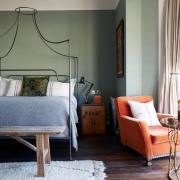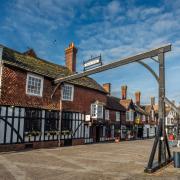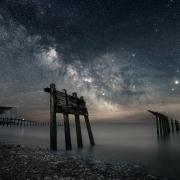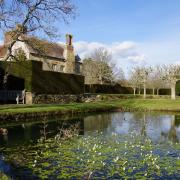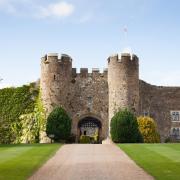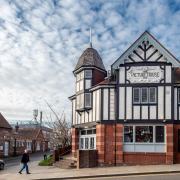From a superyacht that cost 750,000 euros a week to an 18-course dinner at a three Michelin-starred restaurant, here's how to get a taste of the buena vida in the Catalonia capital
The giant H on the sundeck was distracting. No matter how much I turned this way or that on the lounger, or squinted into the sun to try and obliterate it, the huge letter stood out, ruining my view.
The staff who were discreetly laying out a giant table for lunch behind me had placed chairs, and even a parasol, right in the middle of it, but there was no disguising the capital letter. Highlighted in luminous white, it dazzled, looming out from the elegant teak deck.
What has possessed someone to destroy such a beautiful area, I thought, especially as it was right on the top of the superyacht, Stella Maris, berthed in Marina Port Vell, in Barcelona.

Just then the captain walked by. ‘No helicopter today,’ he smiled, nodding towards the stern of the yacht, and I blushed, embarrassed by my nautical stupidity. This wasn’t a sundeck at all – it was the helipad, and I wasn’t a guest on this behemoth vessel.
I had snuck away in the middle of a tour of the 750,000 euros-a-week yacht to see how the other (far richer) half live. The answer was simple: in totally and utter luxury. With 19 crew to look after 12 guests, Stella Maris offered seven-star accommodation.

As well as a Beach Club and full heliops helipad, limousine, and seven cabins – the owner’s suite at the bow has his and hers bathrooms, a dressing area, office, private terrace, and sundeck – there's also a piano, gym, full spa with sauna, Hammam, and Jacuzzi massage room. And no need to worry about going up and down the stairs between decks – there's a lift to stop guests exerting themselves too much.
Any energy they do have can be used on the zodiac, Kayak, electric bikes, water skis, wake board, Wave runners, Seabobs and plethora of ‘toys’ that come with the superyacht.
Taking a peek at the lunch menu – a duo of crab, beef fillet with foie gras butter, potato rosti and spinach, followed by apple crumble washed down with a Louis Roederer Rose – it was time to leave. After all, I was at the annual MYBA Charter Show in Spain’s second largest city (and the capital of Catalonia) and there was plenty more superyachts to see.
In fact, Marina Port Vell is the only one in the Mediterranean to be able to take the biggest superyachts – 18 of which are here for the show. MPV bosses plan to take out two of the pontoons to make it even bigger so that even more giant (and gorgeous) superyachts can berth here.
With guaranteed sunshine and temperatures up to 40 degrees, this Mediterranean hot spot is a hub for luxury as well as tourism.
So, it was fitting that stepping off the Stella Maris, we headed into La Exiample to Barcelona’s ‘Fifth Avenue’ Passeig de Gracia, which starts at Placa Catalunya and ends at Diagonal, at the Jardinets de Gracia, some of the city’s most emblematic places.
Here, we went into Rabat, a family-owned jeweller’s that has gone from hyper-local to a high-end Catalonian brand. From a dazzling one-of-a-kind Red Carpet collection that features canary yellow diamonds as big as olives to ropes of luminescent Japanese pearls, this is the brand that adorns Spanish finest and most famous.
Nestled alongside Chanel, Gucci, and Dolce & Gabbana is a distinctly home-grown designer store: Santa Eulalia. Among the top 30 men’s stories in the world, according to Pitti Uoma, and The Business of Fashion it was founded in 1843, and is the oldest fashion store in the city.
Showing us round, owner Luiz Sanz, whose great grandfather took over the business, pointed out his curation of the world’s luxury fashion brands from Burberry to Balenciaga, along with their own luxury perfumes which sells in Harvey Nichols and at Liberty in London.

‘Smelling like everyone else is a little bit vulgar,’ the uber elegant Luiz smiled. ‘We wanted to create something unique and we were one of the five finalists in The Fragrance Institute of New York.’ Many, including Marinis, a fresh sea-inspired scent and Crocus, a heady saffron fragrance that’s intoxicating, are perfect for men and women who like their fragrances to stand out from the rest.
As well as selling the best of the world’s fashion brands for men and women, the store still has a bespoke tailoring department, and Luiz showed us the tailors hard at work, through a large glass window. ‘The former King of Spain was a customer,’ he explained. ‘and he suggested putting in the window so we could see the tailors’ shop. It was a great idea and he loved it when he saw it finished.’
Luiz has another secret in the store – a champagne bar and fantastic terrace hidden behind a curtain in the women’s fashion section, which is curated by his wife Sandra. ‘It’s so you can sneak away for a bite to eat or something to drink,’ he said, offering us a glass of chilled bubbly.
‘I could get used to this,’ I smiled. Champagne was on the menu later in the day, too at Abac, a three-Michelin-starred restaurant run by chef Jordi Cruz.
Bold, creative and using seasonal produce, the restaurant was nominated as the best in Barcelona in 2011 and now boasts 18-course tasting menus that are as whimsical as they are delicious.

I’m a vegetarian, but Jordi – who has accumulated an impressive six Michelin stars for his restaurants - manages to infuse bite-size morsels with incredible flavours that look as good as they taste, filling up my Instagram feed as well as delighting my palate. From a Bloody Mary with a difference – even the ice cubes are tangy, spicy and moreish – to a metamorphosis of tapas that looked like a witchetty grub that turned into a deep fried butterfly, but thankfully wasn't, to a lipstick sorbet, this is a foodie marathon not a sprint, and we dined and drank for more than four hours. It’s no wonder Abac has been hailed as a ‘culinary temple.’

Back at my hotel, the five-star Casa Fuster, I vowed never to eat again. Instead, I explored this luxurious hotel, presiding over Paseo de Gracia, discovering it was originally a house designed by Catalan architect Lluis Domenech I Montaner as a gift for the owner Mr Fuster’s wife. He used so much marble, and other luxurious décor and interiors, it became the most expensive hotel in Barcelona. Nowadays, tourists and residents flock here for the panoramic views of the city from the rooftop terrace.

Design is as important here as gastronomy and Barcelona is home to arguably the greatest and most recognisable architecture in the world by Antoni Gaudi. Creator of the famous Sagrada Familia, his jewel, Casa Mila is in Barcelona’s Eixample. Up close it’s a breath-taking piece of work with its curved form, meant to mimic nature.

Built between 1906 and 1912, La Pedrera, as it’s also known, which means stone quarry in Catalan, is now a UNESCO World Heritage site, and also houses a cultural centre and two female residents. Inside, the apartments show how Gaudi thought about every detail, designing everything himself, including the ergonomic furniture, to the internal garage for horse-drawn carriages, and the intricately shaped chimneys on the roof in The Garden of the Warriors.
A different kind of architecture is on display in the city’s Gothic Quarter with its labyrinthine streets and monumental La Seu cathedral with its 15th-century-stained windows and the relics of Saint Eulalia, the patron saint of Barcelona, as well as the cloisters.
After all that sight-seeing, it was time for lunch at the award-winning Estimar run by the Gotanegra family and chef Rafa Zafra. An intimate restaurant, only big enough to seat 15 people, we found ourselves in the middle of the kitchen with chefs working all around us. Dish after delicious dish was expertly prepared, cooked and delivered to the table while we watched fascinated and sipped Cava (pronounced with a b instead of a v in Catalan).

I stopped counting how many courses there were after 10, but was stunned to find my fellow diners feasting on the stuffed stomachs of sea cucumbers – a delicacy in these parts – and barnacles which cost 180 euros per kilo. ‘Amazing,’ everyone declared, using their finger nails as instructed to cut through the top of the barnacle and tease the contents out, but I was more than happy with my tempura asparagus.
For more than three hours we ate, leaving us just an hour and a half to return to the hotel to freshen up before dinner. ‘I can’t possibly eat anymore,’ I insisted, but later on the rooftop restaurant The Serras – which has one Michelin star under the guidance of chef Marc Gascons - I tucked into fried artichokes while taking in the view over Marina Port Vell. The lights on the superyachts twinkled as the sun set and the city came alive at night– the perfect ending to a luxurious stay in beautiful Barna.





